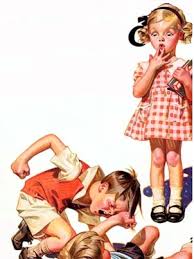Children fight because they often don’t have the vocabulary or skills to negotiate conflict. They also have a harder time calming themselves down to use those skills in the heat of the fight. If they have ways to cope with conflict in their mind beforehand, they are going to have a much easier time during the conflict.
During a family meeting or at a time when your child is calm, practice the following skills.
Pick a potential conflict two children could have. You could google an illustration of that problem so your daughter has the visual support of what the issue is. Ask her “What is happening in this picture”? “What could the child do to solve this problem?” Write down what she says. Even if she can’t read, writing her ideas down validates your child. Let your child come up with her responses first. Then support her with other options untill, after many times practicing different scenarios, she can come up with multiple solutions to the problems. Repeat back what the solutions are.
So if the scenario is that one girl wants a tricycle another boy is riding, you would say,
“What is happening in this picture?”
“What could the girl do?”
Your child may say any of the following responses.
- She could ask for the tricycle.
- She could wait her turn.
- She can flip a coin or play rock-paper-scissors to see who gets the trike.
- She could find another trike.
- She could do something else.
- She could ask her dad to set the timer so she can have a turn in five minutes.
- If many children are there, she can put her name on a piece of paper showing that she is next in line.
- She can hit the boy/push him off the trike.
- She could use her magic powers to make the trike come to her.
Write down the last one WITH NO JUDGEMENT. Also, children will often purposely say silly things. Write those down so this exercise can be fun, too.
Then you and your child could act out the different scenarios. If your child practices saying these lines as if she is in the situation, her brain is more likely to remember what to do in the heat of the moment.
After your child has done this problem solving on a few occasions, add the next piece. Choose one solution and then brainstorm the consequences to that solution.
So you could pick, “She can hit the boy/push him off the trike.” Then you would say, “What might happen if she chooses this solution?” The child might say some of the following responses.
- The boy might hit her back.
- The boy might tell his parents.
- The boy might get really hurt and have to go to the doctor.
- The boy might cry.
- The girl might have to go home.
- The parents might not let the girl have a turn at the trike.
Then you could take another solution such as “She can put her name on a piece of paper showing that she is next in line.” You would say, “What might the consequences of that solution be?”
- The girl won’t get in trouble.
- The girl doesn’t get hit.
- The girl waits and eventually gets a turn.
- The adult in charge forgets to reinforce that it is her turn after five minutes.
In our class, I sometimes have the class play tic tac toe with the boys against the girls. Everytime someone comes up with a solution their team gets an x or an o. The kids love this.
Not only does this method teach children to solve a specific problem, but it helps children behave less impulsively and they learn the lifetime skill of finding multiple solutions to their problems.
REFERENCE
Shure, M., Digeronimo, T. F., & Aher, J. (2000). Raising a thinking child workbook: Teaching young children how to resolve everyday conflicts and get along with others . Champaigne, Illinois: Research Press.



